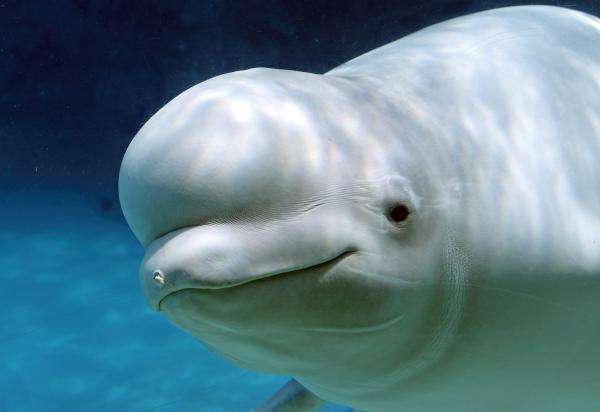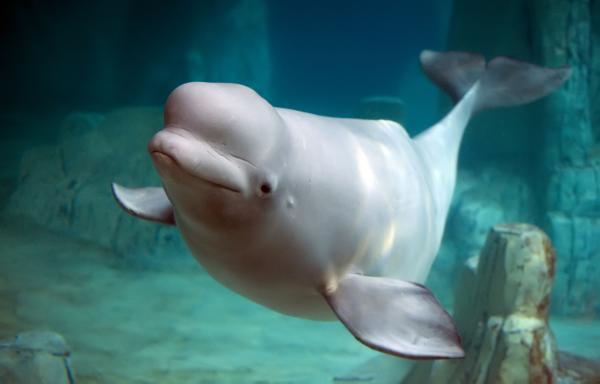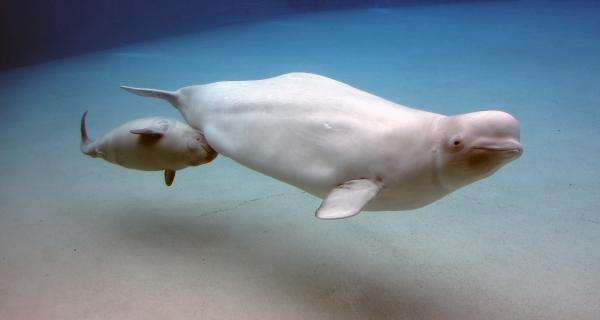The beluga whale (Delphinapterus leucas) is one of the most fascinating marine mammals, easily recognized by its iconic white color and unique adaptations. In this article, we’ll explore everything about the beluga whale—including its physical features, where it lives, how it uses echolocation, what it eats, and how it reproduces. Whether you’re a wildlife enthusiast or searching for SEO-friendly beluga whale facts, this guide has you covered.

Taxonomy: Beluga whales belong to the Monodontidae family—a small group of toothed whales, which also includes the narwhal.
Color: Adults are completely white, making them unique among all cetaceans. Calves are born gray or cream-colored, gradually turning white as they age. The name “beluga” means “white” in Russian.
Body Structure: Belugas lack a dorsal fin, have a pronounced rounded forehead (“melon”), and a flexible neck—features not seen in most other whales.
Size: Belugas are medium-sized whales, typically ranging from 3 to 5.5 meters (10–18 ft) in length.
Social Behavior: Belugas are highly social, often forming groups (pods) of up to 25 individuals. They are famous for tactile communication and their broad range of vocalizations—earning the nickname “canaries of the sea.”
Respiration: Like all whales, belugas have lungs and must surface for air. They can hold their breath for up to 15 minutes.
Swimming Speed: Average swimming speed is about 10 km/h (6 mph).
Circumpolar Distribution: Beluga whales are found throughout Arctic and sub-Arctic waters in the Northern Hemisphere.
Preferred Habitats: They inhabit shallow coastal areas, including bays, estuaries, and fjords—especially in regions of Canada, Alaska, Greenland, Russia, and Norway.
Migration: Some beluga populations migrate southward during the winter to avoid dense ice and return north during summer.
Ice Adaptation: Many belugas live near or under sea ice (pack ice) and are well-adapted to cold conditions, thanks to a thick layer of blubber that provides insulation and buoyancy.
River Visitors: Occasionally, belugas venture into freshwater rivers like Canada’s Yukon and Russia’s Amur.
One of the beluga whale’s most remarkable features is its ability to use echolocation:
The Melon: The prominent, flexible forehead houses a fat-filled organ called the melon, which focuses and modulates sound for echolocation.
How It Works: Belugas emit a series of clicks and whistles via their nasal sacs (they lack vocal cords). These sounds travel underwater, bounce off objects, and return as echoes, which are received and interpreted through the melon. This allows belugas to “see” their surroundings, locate prey, and navigate icy or dark waters—even under thick sea ice.
Communication: Besides echolocation, belugas use a wide array of sounds for social interaction—hence their reputation as some of the most vocal whales.

Diet: Belugas are opportunistic predators that feed on a variety of prey in both saltwater and freshwater environments.
Typical Prey: Their diet includes fish (salmon, cod, smelt), mollusks, crustaceans, octopus, worms, shrimp, and squid.
Foraging Techniques: They use echolocation to hunt and sometimes work together to herd fish. Belugas also blow jets of water into the sea floor to uncover buried prey.
Predators: The main natural predator of belugas is the polar bear. Many belugas show scars from polar bear attacks.
Gestation: Female belugas have a long gestation period of 14–15 months, giving birth to a single calf that measures about 1.5 meters (5 ft) at birth.
Birthing Sites: Birth usually occurs in warmer, shallow coastal waters to provide a safer environment for the newborn.
Parental Care: Mothers nurse their calves for up to two years and form a strong bond to ensure their survival.
Feeding: Once their teeth appear, calves begin eating solid food such as small fish and squid.
Reproductive Cycle: Female belugas typically give birth every three years and remain fertile for about 20 years.

Breathing: Belugas can dive for up to 15 minutes before needing to surface.
Blubber: Their thick blubber layer not only keeps them warm but also aids in buoyancy.
Population Status: While some populations are stable, others are threatened by habitat loss, climate change, and hunting. Conservation efforts are in place in many regions to protect belugas and their habitats.
Bibliography
Beatty, R., Beer, A., & Deeming, C. (2010). The Book of Nature. Great Britain: Dorling Kindersley.
Prevost, J. (1995). Beluga Whales. Minnesota: Abdo & Daughters.
Furgang, K. (2019). Beluga Whales. New Jersey: Enslow Publishing.
animal tags: Beluga Whale
We created this article in conjunction with AI technology, then made sure it was fact-checked and edited by a Animals Top editor.